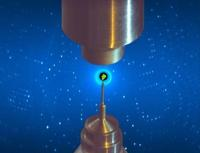Speaker
Description
PcyA reduces biliverdin IXα (BV), a heme degradation product, in a ferredoxin-dependent manner, to synthesize phycocyanobilin, which plays an important role in photosynthesis and biological photoresponse. PcyA is a unique enzyme that sequentially reduces D-ring vinyl group and A-ring vinyl group of BV in a site-specific manner. In this study, Ile86 located near the important amino acid Asp105, which has been thought to be a proton donor to BV, was substituted (I86D mutant). Interestingly, the absorption spectrum of the complex of PcyA mutant I86D and BV shows a significantly high absorption peak at730 nm as compared with the wild type PcyA and BV complex. Its absorption maximum is presumed to be derived from BVH+ with protons added to BV by PcyA in the first step reaction, but hydrogen atoms cannot be identified even by high-resolution X-ray crystal structure analysis. Therefore, we have been engaged in neutron crystallography to visualize the structure of BVH+ and the protonation state of amino acids in PcyA.
As a result of the neutron crystal structure analysis, we could observe the state of BVH+ protonated by BV reduction. This result was consistent with the results of spectroscopic and computational studies. Both Asp 105 and mutated Asp 86 were protonated and formed hydrogen bonds. We were able to identify the hydrogen-bonding network of the active site which could not be identified by high-resolution X-ray crystal structure analysis.

